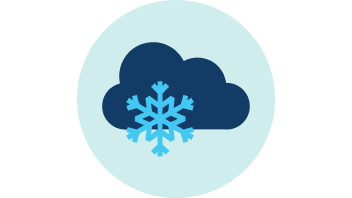Winter storms
Winter storms kill more Canadians than tornadoes, thunderstorms, lightning, floods and hurricanes combined.
Hazard information
Heavy snowfall and ice can make the roads treacherous and interrupt the power supply.
You can check local weather and forecasts online.
Interactive maps, road conditions and driving information is available through Traveller Information Services.
Check with your local school board for information on cancelled classes and buses.
Check with your local municipality for information on snow removal services and special rules in place during a snow emergency.
Safety tips
- Avoid unnecessary travel.
- Wear layers of lightweight clothing, mittens and a hat (preferably one that covers your ears).
- Wear waterproof, insulated boots to keep your feet warm and dry and to keep from slipping on ice and snow.
- Regularly check for frostbite — numbness or white areas on your face and body (ears, nose, cheeks, hands and feet in particular).
- Avoid overexertion when shoveling snow by taking frequent breaks.
- Bring pets inside and move livestock to sheltered areas with non-frozen drinking water.
If power outage results:
Prepare now
Take the following steps so you and your household are prepared in the event of an emergency:
- build an emergency preparedness kit in case a power outage or winter conditions prevent you from being able to leave your home. Your kit should include items like:
- a flashlight
- water
- non-perishable food
- extra blankets and warm clothes
- winterize your home to retain heat:
- insulate walls and attics
- caulk or weather-strip doors and windows
- install storm windows or cover windows with plastic
- shut off your outdoor water or insulate your outdoor pipes
- get heating equipment and chimneys cleaned and inspected once a year
- trim branches hanging over your house or vehicle so they don’t get weighed down with snow and ice
- stock up on salt to prevent falls on your driveway or sidewalk
- test your smoke and carbon monoxide detectors to make sure they are in good working order
Updated: October 20, 2025
Published: August 26, 2015
